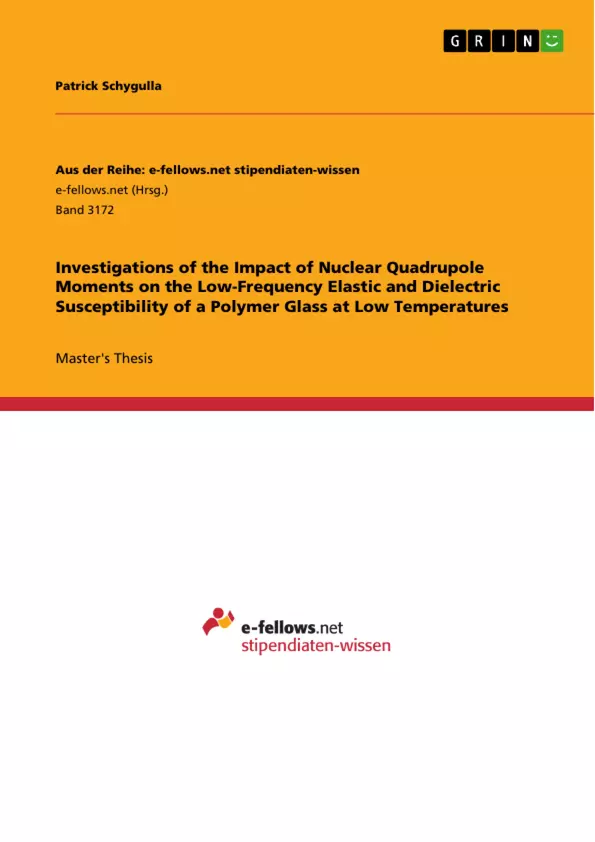This work investigates the impact of nuclear quadrupole moments on the low-frequency elastic and dielectric susceptibility of a polymer glass at low temperatures. In this work low-frequency elastic and dielectric susceptibility measurements of a polymer glass were performed at low temperatures. The sample, a polymer with the trade name FR-122P, was chosen because of its high bromine concentration.
Recent studies of glasses containing nuclear quadrupole moments have revealed deviations in the dielectric function from the predictions of the standard tunnelling model. Within this thesis the low-frequency elastic and dielectric properties of the polymer glass FR-122P were studied at temperatures ranging from 7 mK to 600 mK. A double paddle oscillator was used for elastic and a capacitance bridge for dielectric susceptibility measurements covering a fre-quency range between 60 Hz and 16 kHz. The large amount of nuclear quadrupole moments in the investigated sample and the well known hyperfine level splitting enabled a thorough analysis of the role of nuclear quadrupole moments in this system. With the help of nume-rical calculations it could be shown that above around 200 mK the results agree with the standard tunnelling model while towards lowest temperatures interactions between nuclear quadrupole moments and atomic tunnelling systems need to be considered.
Comparing the simulations with the measured data implies that the interactions result in an additional relaxation process rather than in changes of the tunnelling system distribution function. A novel experimental module was developed with the goal to directly study the influence of nuclear quadrupole moments. It allowed for selectively driving the nuclear quadrupole transition while simultaneously measuring the elastic susceptibility.
Inhaltsverzeichnis (Table of Contents)
- Introduction and Motivation
- Theoretical Background
- Low-Temperature Dynamics in Glasses
- Glass Formation and Thermal Properties
- Structure of Amorphous Materials
- Energy States in a Double Well Potential
- The Standard Tunnelling Model
- Frequency Response of Amorphous Samples
- Nuclear Quadrupole Moments
- Nuclear Quadrupole Resonance
- Resonant Susceptibility
- Relaxation Mechanisms
- Low-Temperature Dynamics in Glasses
- Experimental Methods
- Working at Low Temperatures
- Cooling Methods
- Thermometry
- Polymer Glass FR-122P
- Chemical Structure
- Sample Production
- Material Choice
- Acoustic Measurements
- Double Paddle Oscillator
- Measurement Strategy
- Probing the Nuclear Bath
- Dielectric Measurements
- Working at Low Temperatures
- Results and Analysis
- Preparatory Measurements
- High Temperatures
- Background
- Voltage Scaling
- Thermalisation
- Complex Acoustic and Dielectric Susceptibilities
- Temperature Overview
- Acoustic Measurements
- Dielectric Measurements
- Numerical Calculations
- Standard Tunnelling Model
- Resonant Susceptibility
- Additional Relaxation Rate
- Impact of RF Bias
- Preparatory Measurements
- Discussion
- Validity of Data
- Conclusion
- Interpretation of Results
- Comparison to Related Work
- Outlook
- Summary
Zielsetzung und Themenschwerpunkte (Objectives and Key Themes)
This thesis investigates the impact of nuclear quadrupole moments on the low-frequency elastic and dielectric susceptibility of a polymer glass at low temperatures. The study aims to understand the role of these moments in the glass's dynamic behavior and to explore the interplay between nuclear quadrupole moments and atomic tunnelling systems.
- The influence of nuclear quadrupole moments on the low-frequency elastic and dielectric properties of a polymer glass at low temperatures.
- Comparison of experimental results with predictions of the standard tunnelling model.
- Analysis of the interactions between nuclear quadrupole moments and atomic tunnelling systems.
- Development of a novel experimental module to study the influence of nuclear quadrupole moments directly.
- Investigation of the relaxation processes involved in the system.
Zusammenfassung der Kapitel (Chapter Summaries)
The first chapter introduces the topic and outlines the motivations behind this research. Chapter 2 provides a theoretical background on low-temperature dynamics in glasses, including the standard tunnelling model and the role of nuclear quadrupole moments. The experimental methods used in this thesis are detailed in Chapter 3, focusing on the preparation of the polymer glass sample and the measurement techniques for elastic and dielectric susceptibility. Chapter 4 presents the results of the measurements and their analysis, comparing them with the predictions of the standard tunnelling model and exploring the impact of interactions between nuclear quadrupole moments and atomic tunnelling systems. Chapter 5 discusses the validity of the data, interprets the results, and compares them to related work in the field. Finally, the thesis concludes with a summary of the findings and outlines future directions for research.
Schlüsselwörter (Keywords)
This research focuses on the impact of nuclear quadrupole moments on the low-frequency elastic and dielectric properties of a polymer glass at low temperatures. The primary keywords and concepts include: glass transition, tunnelling model, atomic tunnelling systems, nuclear quadrupole moments, hyperfine splitting, resonant susceptibility, relaxation processes, dielectric function, elastic susceptibility, and low-temperature physics.
- Quote paper
- Patrick Schygulla (Author), 2018, Investigations of the Impact of Nuclear Quadrupole Moments on the Low-Frequency Elastic and Dielectric Susceptibility of a Polymer Glass at Low Temperatures, Munich, GRIN Verlag, https://www.grin.com/document/491538



